Implementing Kanbanize across the company and training employees on the Kanban Method has brought several key results for SSOE Group.
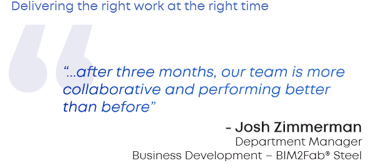
SSOE Group is a global project delivery firm for architecture, engineering, and construction management with the mission to make their clients successful by saving them time, trouble, and money.
To live up to that promise, SSOE was looking for ways to integrate Lean practices and drive performance by enhancing collaboration and optimizing department and project management workflows.
One of the main challenges identified by SSOE on the path to global Lean Project Delivery was a lack of visibility across locations and team members. The physical distance and time zones between locations can make it more complicated for team members to have an overview of what their colleagues are currently working on, whether they need assistance, or how they can help. This lack of visibility can create gaps in communication, which can result in duplication of efforts and rework.
Before introducing Kanbanize as a company-wide tool, some individuals and groups in SSOE were using free online tool alternatives like Trello or a physical Kanban board to manage their work. Having different people spread across various tools made it difficult to have an overview of the entire workload, project status, or free capacity in a team or division.
Implementing the software across the company and training employees on the Kanban Method has brought several key results for SSOE.
Kanbanize has helped SSOE visualize the flow of work within teams throughout the company. Using digital Kanban boards to structure work processes and manage work items has improved the coordination and scheduling between the different work stages of a task and within those teams.
How did SSOE achieve this? Starting with simple, physical Kanban boards, each team defined their workflows to visualize major steps in a deliverable process. This ensures the stages are explicitly listed and accounted for during the project lifecycle. These physical boards were then recreated in Kanbanize for the teams to utilize. They found the visualization of work items as they approached each stage allowed for better agile resource planning.
Card templates are utilized for fast, consistent, and efficient card creation of repetitive processes. “Checking” is an example of a template utilized; the quality control stage of the process requires various steps to be followed, and the ability to save checklists as card templates streamlined the communication of verification steps. The external link feature of Kanbanize allows for a link to the internal data management system, directing task assignees to necessary documentation.
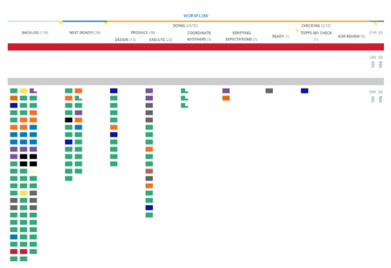
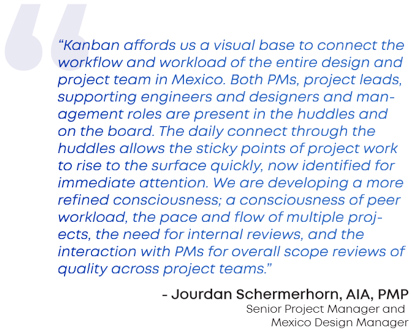
Through operational transparency in work requirements and processes, potential project waste (ie., rework, duplication of efforts, task switching, searching for information) became easy to identify and remove, supporting project efficiency and quality.
The visualization of tasks, priorities, projects, and deadlines allowed for greater staff liquidity. Having a real-time overview of task status and workload also enabled decision-making on how to best allocate resources to meet deadlines.
Visualizing the work items, where they are blocked, and who has free capacity has encouraged incremental process improvement when determining work, identifying bottlenecks, and resource allocation in various teams. For example, due to the technical nature of some of the work, many staff members have specialized skill sets. As a result, some tasks cannot be executed by anyone else. The visualization of work has allowed team members to transfer non-specialized work items to other team members and allow them to focus on tasks that need their specific skill set. This has also provided more opportunities for mentoring and allowed junior-level staff to learn new skills and gain operational knowledge.
Prior to daily huddles, which are 15-minute stand-up meetings, some departments had experienced a lack of transparency in relation to the availability of work to other team members. When an individual received a request, they were required to switch tasks and complete it even if the execution did not require their specific expertise. Visualizing the department workload has encouraged the mentality of “our work” instead of “my work.” Being able to transfer tasks between team members depending on their capacity and skill set has enabled teams to minimize task switching and utilize resources more effectively.
Visualizing the work has also opened the door for more collaboration between team members. Seeing what colleagues are working on has made it easier for others to offer help and share their experience from similar situations.
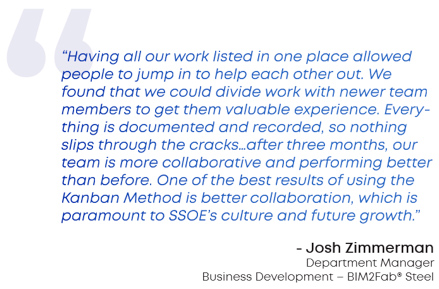
Some teams integrated team collaboration into their workflow by adding a “lessons learned” column within the “done” section of their boards. Moving a card into the lessons learned column indicated the task is complete but that there is an opportunity for improvement or success story that should be shared with other team members. This column served as a visual reminder of the importance of feedback and continuous improvement.
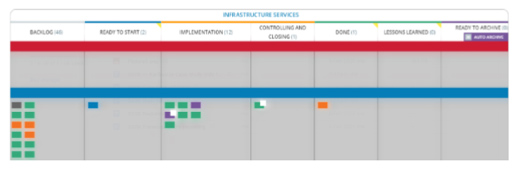
Implementing Kanbanize was part of a company-wide Kanban initiative for SSOE. Identifying Kanban as a methodology to the corporation was the first step on the project delivery firm’s path to Lean Project Delivery. SSOE started internal Kanban training and is using the Kanban Maturity Model to measure progress and define the next steps.
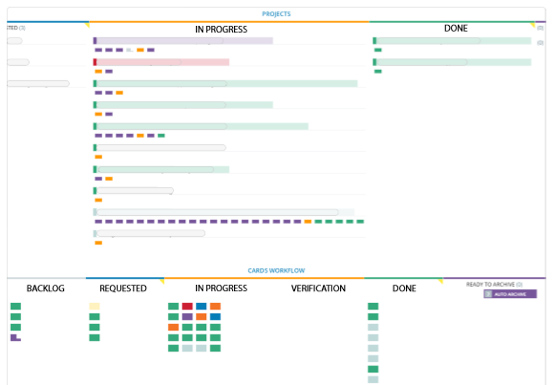
After becoming familiarized with the methodology, teams were onboarded into the software. Implementation went smoothly due to committed management support, a dedicated team of coaches, and a detailed rollout and communication plan, combined with the Kanbanize support and knowledge base. SSOE didn’t need to create instructions for users on how to use the software because the Kanbanize support and robust knowledge base had all the information the teams needed. Team members are referred to various articles and instructions within the knowledge base.
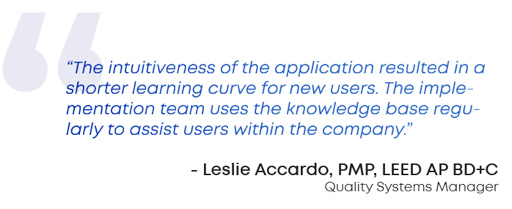
The Kanban Maturity Model is a framework for scaling Kanban across your organization that facilitates the definition of a realistic roadmap for improving business agility. It plays an important role in creating unity, alignment, a sense of purpose, and good governance.
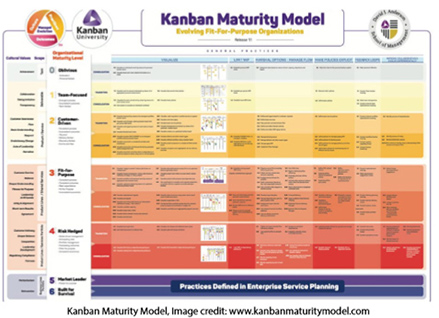
Kanban Maturity Model Assessments are completed approximately three months after teams complete their Kanban training. The original intent of the assessments was to provide the training coaches with a baseline and metrics to measure progress as teams start and continue to utilize Kanban. The unexpected benefit of the assessments is the information provided to department managers, which helps them measure their progress and look for opportunities for improvement. Through the use of Kanbanize, they are utilizing work types to help gather metrics for various types of activities.
SSOE also shared additional success factors for their company-wide implementation of the tool and general shift toward the Kanban Method as a work management approach:
SSOE piloted an internal program for employing the Kanban Method with a group of architects and designers in a two-day workshop. The goal of the pilot was to take a narrow and deep approach to implementation, studying the group through their trials and triumphs before rolling it out to other groups in the organization. Those in the pilot group responded very positively to the change, with junior-level staff reporting an increase in operational knowledge and exposure to more diverse tasks than before. Soon thereafter, the pilot group then began using Kanbanize. Several platforms were considered and explored prior to deciding on Kanbanize, which has benefits that far outweighed the other options.
Daily huddles have been an effective way to develop a Kanban culture in the company while utilizing the Kanbanize work management environment. Kanbanize allows more visualization of the team’s tasks, with daily huddles offering opportunities to discuss ongoing work and bottlenecks. This not only opened doors for better team discussions and knowledge exchange, but it quickly became a natural part of the work day.
When onboarding their teams into the software, SSOE gave each group the freedom to organize their boards based on their unique workflows. Starting with the standard Kanban board structure, the teams were able to add and split columns, add multiple swimlanes, and color code their cards depending on their specific work processes. SSOE empowered team members by encouraging them to define and own their work process instead of requiring them to work within a standardized framework.
Creating and utilizing feedback loops is a fundamental step in utilizing Kanban. Feedback can be initiated during the daily huddles, weekly replenishment meetings, or monthly retrospective meetings.
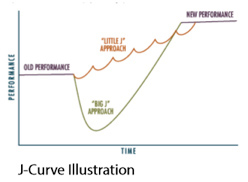 Before logging into the software, teams completed a one-day internal Kanban Method and Lean Principles training. Understanding the methodology and principles was a necessary first step before diving into workflow optimization and visualizing the team’s work. The Kanban Method encourages an agile approach to change. At SSOE, Kanban coaches continuously work with each team to introduce small j-curve effects (i.e., “little J” changes) that encourage incremental and evolutionary change to their current process rather than large j-curve effects (i.e., “big J” changes) that typically create a dip in performance — and ultimately morale — before any improvements are seen, as displayed in the illustration to the left.
Before logging into the software, teams completed a one-day internal Kanban Method and Lean Principles training. Understanding the methodology and principles was a necessary first step before diving into workflow optimization and visualizing the team’s work. The Kanban Method encourages an agile approach to change. At SSOE, Kanban coaches continuously work with each team to introduce small j-curve effects (i.e., “little J” changes) that encourage incremental and evolutionary change to their current process rather than large j-curve effects (i.e., “big J” changes) that typically create a dip in performance — and ultimately morale — before any improvements are seen, as displayed in the illustration to the left.
SSOE made a SharePoint site available for storage of coaching material and various resources for employees following their training. To further support their employees on the organization’s Kanban journey, SSOE also launched a “Lean Coffee” format that offers a space for Кanban and Kanbanize-related discussions and knowledge sharing.
Maturing in the way they use Kanbanize and in their adoption of the Kanban Method overall, SSOE plans to introduce cross-divisional project management by utilizing the Management Workspaces in the software next.
Seeing the need for interdepartmental share, SSOE’s latest goal is to move away from siloed divisional work and move toward project-level Kanban. For this purpose, the firm plans to utilize the Management Workspace in Kanbanize for project management tracking.
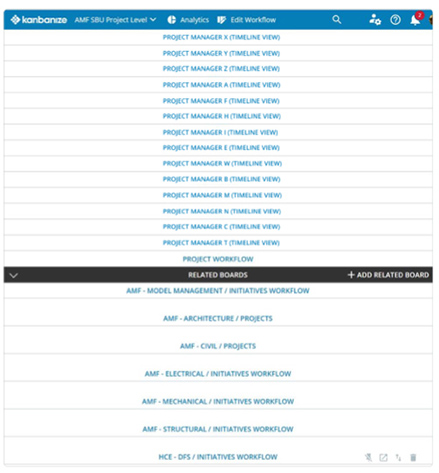
Currently, SSOE is testing a structure with projects visualized as initiatives in the Management Workspace and linked to sub-initiatives on discipline boards. Once the sub-initiatives land on the discipline board, teams will manage the work themselves, breaking down tasks and moving work items through their workflow.
The benefit of this work structure is that the status of the project-related work in the different divisions will be visible to the project manager in real-time on a single board. There will be no need to click or ask around to gather information from the different divisions.
Applied at a company level, Kanbanize created an infrastructure for cross-divisional project management and collaboration. Through its various Kanban-style features, the software offers an environment that supports Lean Project Delivery at scale:
In this episode, I sat down with Beejan Giga, Director | Partner and Caleb Emerson, Senior Results Manager at Carpedia International. We discussed the insights behind their recent Industry Today article, “Thinking Three Moves Ahead” and together we explored how manufacturers can plan more strategically, align with their suppliers, and build the operational discipline needed to support intentional, sustainable growth. It was a conversation packed with practical perspectives on navigating a fast-changing industry landscape.